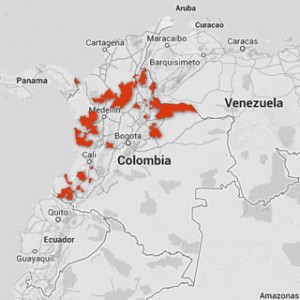“Originally born from the teachings of the Second Vatican Council in 1962, they (ELN) grew to become one of Colombia’s biggest kidnapping organizations.”
A BRIEF HISTORY
Who is ELN? The National Liberation Army is an armed group involved in the continuing Colombian armed conflict and have existed since 1964. ELN advocates for a communist ideology of Marxism; “the political, economic, and social theories of Karl Marx including the belief that the struggle between social classes is a major force in history and that there should eventually be a society in which there are no classes”
From the beginning, the ELN was a highly ideological outfit, combining its Marxist outlook with liberation theology, the religious movement inspired by the Catholic Church’s announced shifts in its Vatican II Conference. Some of the group’s first recruits came from the church, including Camilo Torres, a popular and outspoken Colombian priest who died in his first battle in
Vatican II – The council became known for its renewal of Catholic Doctrine (Catholic Church which bases its conclusions on Scripture). Vatican II addressed relations between the Roman Catholic Church and the modern world.
What Colombian Conflict? The Colombian conflict began approximately in 1964 and is an ongoing low-intensity war between the Colombian government, paramilitary groups, and left-wing guerrillas (FARC)(ELN), both fighting to increase their influence in Colombian territory.
Why are they fighting? The reasons for fighting vary from group to group. ELN claims to be fighting for the rights of the poor in Colombia to protect them from government violence and to provide social justice. Both guerrilla and paramilitary groups have been accused of engaging in drug trafficking and terrorism. All involved have been criticized for numerous human rights violations.
“According to a study by Colombia’s National Centre for Historical Memory, 220,000 people have died in the conflict between 1958 and 2013, most of them civilians (177,307 civilians and 40,787 fighters) and more than five million civilians were forced from their homes between 1985 – 2012, generating the world’s second largest population of internally displaces persons”
Since 1981, the ELN has been responsible for 16.8% of killings as well as numerous kidnappings (Alsema, 2013, para. 4).
Founder: ELN was founded in 1960s, by Fabio Vásquez Castaño . ELN is the country’s 2nd largest terrorist group (behind FARC) and it financed thru international drug trade. Supporters are from a more urban areas who operate in northeastern Columbia.

Formation: ELN was first formed after a decade of political violence in Colombia, known as La Violencia (1948–58).
Makeup: ELN is made up of students, Catholic radicals, and left-wing intellectuals hoping to replicate Fidel Castro’s communist revolution in Cuba.
How they are financed: Kidnap/ransom, drug trade. Although the ELN claims they are financed through donations from supporters
ELN areas of interest:
The group operates in the northern & northeastern mountains of Colombia, mostly on the Colombia-Venezuela border region. ELN supporters tend to be in urban areas.
While the ELN originally set out to make a positive difference in the lives of Colombians, their existence is problematic and is responsible for high crime rates and has helped contribute to an unsafe Colombian society.
http://knowledgenuts.com/2014/12/05/the-difference-between-colombias-many-rebel-groups/
Alsema, A. (2013, July 24). Colombia’s conflict cost 220,000 lives since 1958. Columbia Reports. Retrieved from http://www.columbiareports.com

Comments are closed.